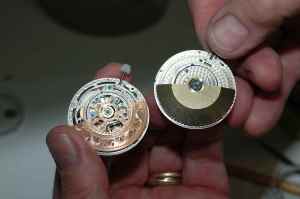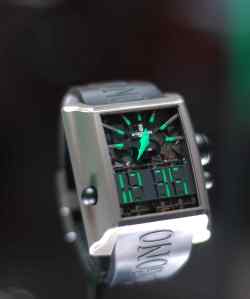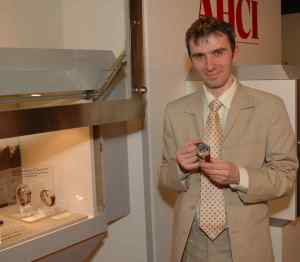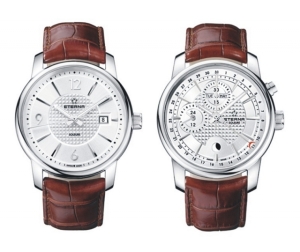Old time in a new bottle
(Part 2-for Part 1, see older post below!)

Some novelties at Baselworld 2010 and a winner
Like every industry, the watch industry likes to speak of innovations. The definition of that word is really in the eye of the beholder.Some are business moves that could shift the general manufacturing paradigm. Because the industry itself has

its own special entropy, where the chaos side of the graph is represented by diversity and this is leading to some genuine innovation. I am referring to the creation of in-house movements. The smallest company with a movement is Armin Strom. The master himself has passed the 70 mark and just powers away without need for external inspiration. The company’s brand new ARM09 movement has been used for the One Week collection. Its modern design is in sharp contrast to Armin Strom’s legendary skeletonized watches, which suggest the voluble baroque decor of Bavarian Catholic churches.


Hublot, too, opened a manufacture in the industrial zone of Nyon last year, which is now producing the Unico movement. Like them or not, the muscular Bangs and the playful Tutti Fruttis are instantly identifiable timepieces and have their very committed fans. CEO Jean-Claude Biver has steered the brand to glory, navigating a bold course straight through the reefs of the Great Recession. A rugged and outspoken warrior of the industry, he wisely gave space to members of the former BNB movement company and brought its select Confrérie des Horlogers on board. So Hublot’s new collection includes the Confrérie’s bullet-shaped “Liberty” watches and the Hublotized “Clef du Temps,” that outlandish confection of diamonds, with a vertical tourbillon visible on the side and an impish complication allowing the user to slow down time for a while. Perhaps a sly comment on the absurdly frenetic pace of our contemporary life.
The techno-vations

The other approach to innovation is to go right to the heart of the matter and change something in the fundamental technology of the watch. This can be quite radical. Let’s mention first of all TAGHeuer, which has been working on replacing the “spring thing” with an engine driven by a permanent magnet of sorts. The “Pendulum Concept” is still being tinkered with, but should it become viable, I am assured, it will remain a sort of niche product and not invade the industry the way quartz did. But the mere idea of electricity inside a mechanical watch (even in the form of magnetism) could raise a few hackles. TAGHeuer has called this little beast a “harmonious oscillator.”

But the TAGHeuer invention is not the only one on the market with that name: After lots of timetable shifting, I met Jacky Epitaux from Rudis Sylva at the Ramada’s third-story bar for an almost conspiratorial look at a mechanism also known as a “harmonious oscillator.” One could almost imagine the ghost of Sidney Greenstreet there looking over our shoulder trying to steel a small but valuable industrial secret. Rather than no spring, this oscillator has two! They are mounted on meshing wheels and mirror each other, so they open and close alternatively and in opposite directions. The point is to cancel the effect of gravity, not just compensate for it as with the regular tourbillon. The system is intriguing, and looking at the oscillator through the loupe feels like trying to play Chopin’s “Minute” waltz with one hand.


Unique means one of a kind
In the end, Baselworld is heaven, and it is hell. On just a few acres there are a sea of watches to be seen — and I have not even touched the jewelry section — and far too little time to explore them properly. Every stylistic idea is represented, the classics and crazies, the sporty and sportive, the cool and the hot, the dressy and the glitzy, the sober and the off-the-perch, the vanilla and jalapeño. There are entire lines of ladies watches, whereby thanks perhaps to the weakening of the Schwarzenegger gene, many men’s watches have become a little more androgynous and are drawing female buyers – but this is another story altogether. The market for diamond encrustations that make some timepieces look as if they could be used to grate a 36-month old Parmesan is going strong, obviously, but there is something to say for a masculine watch arousing latent male personality aspects. (Perhaps if men would wear some made-for-women watches, the world would be a little less violent. Just a thought.)
Of course, luxury is still high on the agenda, but it seems to have become more introspective rather than self-conscious. The owner knows the value, maybe a coterie of family and friends will be in on the secret, and maybe the fan with a quick eye might realize he or she has just seen a Vianney Halter or van der Klaauw flashing by. Yes, a new sense of modesty might be an excellent opportunity for the independent watchmakers, who were especially hard hit by the cash drain. In some ways, these are the industry’s genuine visionaries and artists, whose pieces not only reflect the paradigm, but do a great deal to push its fulcrum into new and as-of-yet undiscovered territory. Twelve of these masters have been beautifully portrayed in a brand new book by top horological journalist Elisabeth Doerr and photographer Ralf Baumgarten, a must have for any watch collector or connoisseur (Twelve Faces of Time, available at teNeues ).

At any rate, it is among this particular — and at times peculiar — brood of out-of-the -boxers, autodidacts or ultimate purists that one can find works of genius, works that leap off the wrist, as it were, especially to the discerning watchista. It may be the colorful, laughing pieces of Alain Silberstein, or the mighty Horological Machines by Max Büsser and his friends, where the steam-punk meets sci-fi. Another piece of gentrified steampunk – combining Charlie Chaplin, Henri Ford and Fritz Lang, to the tune of Honegger’s Pacific 231 – is the “Palace” from Jean Dunand Pièces Uniques, an unabashed celebration of the industrial age, with little chains, cogs, dials and subdials reminiscent of the meters on a locomotive,the nameplate suggesting a fishplate.

A soft-spoken philosopher of time is the Israeli Itay Noy, who customizes very affordable watches by putting famous city squares on the dials, or working with hallucinogenic fractals. He was not the only self-taught craftsman there: Konstantin Chaykin from St. Petersburg had a stupendous clock displaying the Jewish calendar day, a Jewish watch, the Decalogue, that displays specifically Jewish time units – helek and regaim – on the rear. Chaykin also created a Moslem clock, but the work he seems especially proud of is a unique clock that manages to display the Orthodox Easter. How different from the his booth neighbor Rainer Nienaber,a genius of the retrograde, who had a watch on display that doesn’t really tell the time, unless you wish to live in a purely decimal world.

Prima inter pares – counter-entropy

In our age of neue Sachlichkeit, of reductio ad sanem at least, it may seem difficult to find a real show stopper. But maybe we will have to get used to doing without the type of Hollywoodesque hype that has marked the past decades and discover the value of simplicity, of unplugged, of focus. Peace may be more boring than high jinx and wars, but it opens many more possibilities. And so, on day four, while dragging my suitcase full of brochures and electronics through Hall five, between Nienaber and Chaykin (see above), I stumbled across a watch that made me loosen my tie, take a deep breath and rub my eyes. It was a delicate, completely transparent creation with a double axis tourbillon seemingly floating in space right in the middle of the almost square “picture.” The hours and minutes appear on two barrels at the top of the watch separated by a mesmerizing three-dimensional moon, shiny on one side and mat on the other. The watch is reversible. The date is read at 6 o’clock, as it were, on a semicircular barrel that also serves as an oscillating weight for the automatic.So where is the movement? Tucked laterally under the bezel in the side. The author of this phenomenal piece of equipment, the Mysterious Double Axis Automatic Tourbillon is the German watchmaker Thomas Prescher, whose atelier is in Twann close to Biel, Switzerland. If any timepiece at the fair reflected a new sense of concentration on the essentials and a return to sobriety and pure art, it was this one. It should be a pleasure for anyone to be on that wagon.
(This concludes the very personal overview of Baselworld 2010. I tried here to find themes and patterns, not to describe a maximum of brands. So apologies are due for the absence of many eminent watches and brands, and for not mentioning all the extraordinary watchmakers whose work was displayed at the fair. In months to come, I hope to correct that problem through articles and reports).












